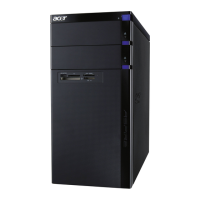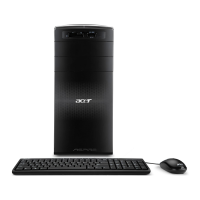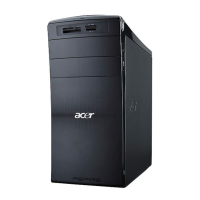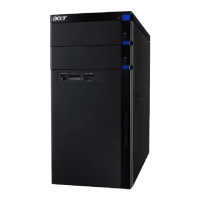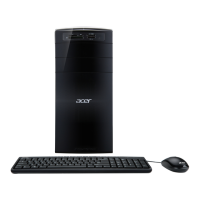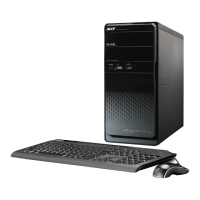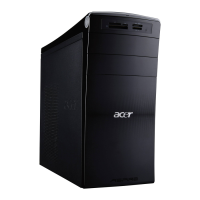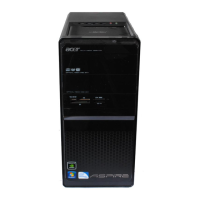Why is my Acer Desktop beeping continuously with one long beep?
- Jjoanna10Jul 30, 2025
The continuous long beep indicates that the memory is either not installed correctly or there is a memory error.
Why is my Acer Desktop beeping continuously with one long beep?
The continuous long beep indicates that the memory is either not installed correctly or there is a memory error.
What does it mean when my Acer Desktop beeps once long and twice short, repeating?
This beep code indicates a problem with the VGA, such as it not being installed or a VGA error, a graphics card error/not installed, graphics card memory error or a graphics card BIOS checksum error.
Why does my Acer Aspire M3410 make two short beeps?
This indicates that the CMOS is damaged.
Brief summary of computer features.
Lists supported operating systems.
Details about the CPU socket and type.
Information on the North and South bridge chipsets.
Specifications of the Printed Circuit Board.
Details on DDR III memory slots and support.
Specifications for SATA ports and drive size.
Support for SATA ODD and depth.
Support for double slot graphics cards in PCIe X16.
Details on on-die graphics and ports.
Information on audio codec and connectors.
SATA connector type and transfer rate.
Gigabit Ethernet controller and port details.
USB controller, quantity, and data rates.
On-board buzzer information.
Types of expansion slots supported.
List of rear panel ports.
Details of various on-board connectors.
BIOS size and kernel information.
Specifications for the power supply unit.
Identifies front panel components with a diagram.
Identifies rear panel components with a diagram.
Itemized processor specifications.
BIOS version, type, size, and boot support.
Lists hotkeys for BIOS setup.
Details on North/South bridges, audio, LAN, HDD controllers.
Tables showing memory slot and total memory configurations.
Detailed specifications for system memory.
Specifications for the audio codec and compatibility.
SATA controller and mode support.
USB class, connectors, and quantity.
Operating temperature, humidity, and vibration specs.
Device power states (S1, S3, S4, S5).
Timer and resume details for device standby.
Timer and resume details for global standby.
CPU, LED, and device states during suspend.
ACPI specification and supported states.
Overview of CMOS Setup Utility and when to use it.
Step-by-step guide to enter CMOS setup.
Key functions for navigating BIOS setup.
Main categories and descriptions within BIOS setup.
Displays system information, not user-configurable.
Settings for system date, time, and halt on error.
Settings for Quick Boot, Quiet Boot, and boot device priority.
Settings for AMD Cool'n' Quiet and Virtualization Technology.
Options to enable/disable onboard controllers and ROMs.
Configures ACPI states, wake-up events, and power loss behavior.
Displays system temperatures, voltages, and fan speeds.
Settings for spread spectrum and overclocking.
Procedures for setting, changing, and removing supervisor passwords.
Resets BIOS parameters to default values.
Saves configuration changes and exits BIOS setup.
Discards changes and exits BIOS setup.
Lists necessary tools for disassembly.
Steps to take before disassembling the system.
Step-by-step guide to remove the side panel.
Steps to remove the front bezel.
Instructions for removing the heat sink and fan.
Steps to safely remove the CPU.
Instructions for removing RAM modules.
Steps to disconnect and remove the HDD.
Steps to disconnect and remove the optical drive.
Instructions for disconnecting and removing the system fan.
Steps to disconnect and remove the daughter board.
Instructions for disconnecting and removing the power supply.
Steps to disconnect cables from the mainboard.
Steps to release tabs and remove the top cover.
Instructions to detach power switch and LED cables.
Steps to remove screws and disconnect the card reader.
Steps to remove screws and cables for top I/O assembly.
Steps to take before assembling the system.
Steps to take before assembling the system.
Instructions for installing the CPU.
Steps to install the CPU cooler and connect its cable.
Instructions for installing RAM modules and memory rules.
Instructions for installing the power supply.
Instructions for installing the I/O shielding.
Steps to install the main board and connect cables.
Steps to install the optical disk drive.
Steps to install the hard disk drive.
Instructions for installing the daughter board.
Steps to install the system fan.
Instructions for installing the wireless LAN card.
Steps to install the VGA card.
Steps to install the front bezel.
Instructions for installing the side panel.
Steps for performing hardware diagnostics.
Guides for power and system checks.
Procedures for external system inspection.
Procedures for internal system inspection.
Explains beep codes and their causes.
Explains checkpoints and their usefulness.
Describes bootblock checkpoints.
Describes bootblock recovery checkpoints.
Steps to recover the system BIOS.
Diagram showing motherboard component placement.
Explains how to set jumpers for correct configuration.
Defines pin configurations for internal headers.
Definition for CPU fan header.
Definition for system fan header.
Definition for Clear CMOS header.
Definition for System Recover HEADER.
Definition for Front USB Headers.
Definition for Front Panel Audio Header.
Definition for Front 1394 Header.
Definition for Front panel header.
Definition for TPM Header.
Definition for Printer Header.
Definition for Audio internal speaker header.
Definition for SPDIF Out headers.
Definition for COM header.
Pin definitions for USB connectors.
Pin definitions for LAN and USB connectors.
Pin definitions for audio connectors.
Pin definitions for IDE/SATA headers.
Pin definitions for VGA connector.
Pin definitions for HDMI connector.
Pin definitions for DVI-D connector.
Pin definitions for PS/2 connectors.
Pin definitions for COM connector.
Exploded view diagram of the computer components.
Lists FRU parts with part numbers and categories.
List of supported CPUs with part numbers.
List of supported memory modules with part numbers.
List of supported Hard Disk Drives with part numbers.
List of supported Optical Disk Drives with part numbers.
List of supported VGA cards with part numbers.
List of supported TV-Tuner cards.
List of supported Card Readers.
List of supported Modems.
List of supported Wireless LAN cards.
List of supported Power Supplies.
List of supported Mice.
List of supported Speakers.
List of supported Keyboards.
